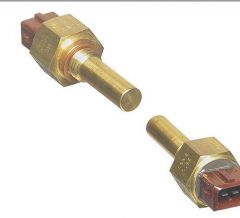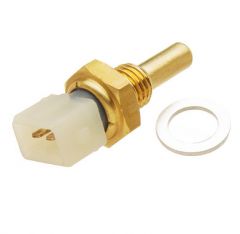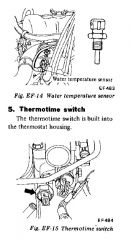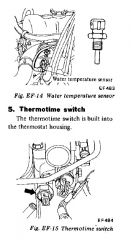
mom'sZ
Members-
Posts
686 -
Joined
-
Last visited
-
Days Won
1
Content Type
Profiles
Forums
Blogs
Events
Gallery
Downloads
Store
Everything posted by mom'sZ
-
Your car is a 74 260Z correct? With all the stuff you already replaced, I'd suggest taking a really good look at the wiring harness. These cars didn't have a great harness way back when and thirty years hasn't helped. Look for burned or frayed sections in the harness. Look at the harness in the engine compartment that hooks to the alternator. Look for signs that it has been tampered with or wasn't secure and got against the engine or touched something. Check all your grounds. Clean the surface they attach to.
-
Any motorcycle builders out there? Need advice on transmission
mom'sZ replied to 9kredline's topic in Miscellaneous Tech
older Harleys had a separate transmission. Some were belt and some were chain. -
throttle position sensor? air boot between AFM and TB? massive vacumn leak? fuel system clogged? broken wire on tps? just throwing stuff out there to try to get you started. Because you had it apart, then it won't run right, something happened during reassembly or isn't put back right. Double check all your work.
-
Good Show Zmaster !!!! well done sir. So now, my assumtion is that the connectors are crusty. I would bet they are all crusty. That makes a lot of sense, that if the car had sat up, no components had actually gone bad, but the connections had corroded. The one on the temp sensor is just like the ones on the injectors, so if it is beyond being cleaned up, new ends are readily available and can be spliced in. But go back, unplug the connector and look at it. If it shows signs of corrosion, srcub it with a little tooth brush or something, shoot some electrical contact cleaner in there. Because if it got crusty sitting up, it will work for a little while and then when you are far from home, with no tools....
-
coilover upper collar fittings
mom'sZ replied to ozzinc's topic in Brakes, Wheels, Suspension and Chassis
Most the time the manufacturer of the coil over kit should provide the correct bushing for the struts you are using. -
I like Vegasnative's idea as well if you have a welder, but I usually weld an old 1/2" drive socket onto it. Then you can use the 1/2" breaker bar to turn it. If you don't have a welder, the car should still be drivable, since the old oil is still in there right? drive it to a muffler shop and see if they'll do it for you.
-
the PB blaster sounds like a good idea. Soak it and let it set for a long time, like over nite if possible. Do you mean a standard tranny? You are trying to remove the fill plug on the side of the tranny? The one with a square head on it? How much is left? it's just mutilated to the point where the wrench will no longer slip on. Then the pipe wrench is probably you best bet. I've never not been able to get them out, but a few have been tough. Maybe a pipe on the end of the pipe wrench. And of course, you maybe could heat it with a torch but be careful!!! don't set the car on fire.
-
The sending units for the stock Zcar oil pressure gauge are notorious for going bad. They are expensive to replace as well $40 - $60 buck if I recall depending on if you go OEM or aftermarket. I had one that leaked through the body of the sending unit as well and what a mess! An aftermarket gauge is a good alternative. These motors don't have a boatload of oil pressure when they are right and high milage examples seem to run fine with very little oil pressure. The oil pump has a high pressure relief vavle (I think) that limits the oil pressure to 60 psi. My brand new motor idles at 15-20 psi once warmed up and at mid range rpms is around 40-50 psi.
-
Zmaster: The water temp gauge is seperate from the water temp sensor for the ECU. The gauge and it's sensor are in the regular wiring harness for the rest of the car. The temp sensor for the ECU is in the fuel injection harness, which is a whole seperate harness. Follow the wires back through the bundle if you don't believe me. The sender for the gauge is also in the thermostat housing. It is the little one with only one wire attached with a slid on connector. Just because the gauge still works has nothing to do with the fuel injection. Believe me on this one, I've had this sensor go bad and it does exactly what you describe. Smoked like crazy, won't barely idle and only cleaned up/ran half a$$ decent if you rev the engine. This is because when the sensor goes bad, the ECU goes full rich just to be safe and not burn up the motor. The thermotime switch is a cold start device to richen the mixture when you first start the motor. The EFI bible explains it better but it works something like this. When you first start the motor, juice is sent to the thermotime switch. Juice flows through the switch to the ECU and the ECU richens the mixture for good cold start/run conditions. As the current continues to flow a bi-metal switch in the thermotime switch begins to heat up. As it gets hotter it eventually breaks contact and stops sending juice to the ECU, telling it to stop enriching the mixture. In this way, if you start the car cold it enriches the mixture, then if you run it for a while, then shut it off, then go to restart it quickly (say you run inside the store and come right back out) the motor is still hot and does not need this enrichment. So, because the thermotime switch is still hot, and the bi-metal not making contact, the thermotime does not send this signal to the ECU. Engine heat also keeps the switch from making contact. This way, if the motor is first started cold, it gets enriched. But if it is started, shut off, started again ect, it only enriches until the engine is hot. Hope this makes sense. It's called thermoTIME because it only enriches for a given period of TIME.
-
Here is a link to a screen capture of the factory service manual showing the water temp sensor. The thermotime is there as well. I think the water temp sensor is the smaller of the two. here is a pic of the temp sensor here is a pic of the thermotime
-
Zmaster: Like I said in the other thread, I think now that you fixed your fuel pump issue, it sounds like the water temp sensor is bad. They are only 15$ at any auto parts store, as they are used on numerous models, thay are always in stock. Somewhere I have a link to a picture, I will try to find to show you what it looks like and which one it is. But it is located in the thermostat housing below the water inlet. (where the upper radiator hose enters the engine) The symtoms you describe make me almost positive this is the issue you have now (lots of smoke ect.) As to some of the other stuff you mentioned, for your benefit and others, like m4xwellmurd3r said, the fuel pump is a whole seperate system. It runs or it doesn't run. When it runs, it runs full pressure. Your pressure sounds about right now. The regulator (mounted in the center of the fuel rail, with a vacumn hose running to it) varies the fuel pressure to suit different conditions, but it is a purely mechanical device and not effected by the wiring or ECU ect. Oh... don't run these cars out of gas, they are really tough to get to prime after they run out. Again as m4xwellmurd3r said, the only thing that controls the pulse of the injectors is the ECU. The ECU decides how to set the pulse from inputs from the various sensors. There are only a few, most are quite rudimentry. The water temp sensor tells the ECU how hot the motor is, but it only tells the ECU if the temparture is below 60 degrees F, to compensate for really cold conditions. The AFM tells the ECU how much air the motor is ingesting. The AFM is the main sensor that tells the ECU how much fuel to send. There is an air temp sensor built into the AFM that varies the mixture to match air temp. There is also a throttle position switch. It is really only two sets of contacts, which tell the ECU the throttle is almost closed, almost wide open or somewhere in the middle. This is to lean the idle, richen wide open throttle, or just act normally. The air regulator act to bleed extra air into the sytem to raise the idle on warm up. The thermotime richens the start up, it has a little heater built in and after a given time (thus the name) shuts off. It a super simple system so it is easy to work on. Once it works right it will be reliable for years. It provide good power and fuel economy. For a stock L-6 or near stock, you can't do better. It's been a long road but I think you almost there and now you know how the whole thing works. Good SHOW!!
-
Zmaster, I'll check your other thread next but, having cured or at least worked around your fuel pump issue, it sounds like your water tempature sender is bad. When the water temp sender goes bad, the ECU just goes full rich. It is located in the thermostat housing and they are only fifteen bucks at any auto parts place. Go get one and try it.
-
Lighft01: both your cars are 78s right? Because there are different ECUs and AFMs from year to year and also different from manual and auto, so if you mix and match components you might screw them up. If both your cars are 78s and both manual trannies, you should be fine. The harness will plug into the ECU but the pin outs changed and you can fry the ECUs. If they are different years or trannies you have to swap harness, ECU, AFM and everything all together. (some of this I am pointing out just for others who may find this thread) Because of the fact that you changed the fusible links and the relay started clicking shows the wiring is possibly crusty. The connectors are the real weak link. There may be no problem with the components, it could just be a wiring/connector issue. Check the harness visually. Look at it close, checking for fraying or signs of heat/burning. Look in the EFI bible for procedures for checking the signals or voltages at the connector for the ECU by unplugging the ECU. This way you are checking the component as well as the wiring. This way you measure what the ECU is seeing. Look at each connector. Unplug it and look for loose or crusty pins. Zmaster's example is a good example of the things your dealing with. These things weren't know for great wiring thirty years ago when they were new, and thirty years hasn't helped. If you spray starting fluid in there and it tries that proves it can run and you have some spark, although I'd double check your timing. Also, from the sounds of the first cylinder firing then no more, maybe coil is going. Don't just go buy one, try to check it, swap it with known good one. Does it get really hot after trying to start? On the fuel pump thing, remember the fuel pump only gets juice in the key switch start position. In the key switch on position, the AFM flapper must be open slightly to send the fuel pump juice. Remove the boot between the air cleaner and the AFM. Turn the key to the on position without starting the car, and then stick your finger in the AFM and lift the flap slightly off it's stop, you should hear the fuel pump run when the flap is open slightly. One more thing, I think your fuel pump is the issue, but don't just go buy one, diagnois it. But how cold is it where you are? Because it is a starting issue, you may have thermotime switch or air regulator issue. Again, there are diagnoistic procedures in the bible. But I'm in Florida and don't need either, because it is warm. 240swapped: Don't give up!!! download the EFI bible and use the diaganostic procedures to check the components. Start a new thread with your info (year model mods) and symptoms and we'll try to get you going. ALSO, guys, try to post when you get them going with details of what fixed it so others can benefit from your experience.
-
38 psi is about what it should be in the condition you describe. (bypassing the relay and straight hot wire to pump) But dropping to 4-8 when the car runs is not right. This brings up a good point why it is bad to bypass the relay and saftey switch in the AFM. The only time the fuel rail should see that kind of pressure is when it is running under full load. I'll explain. In the fuel rail there is a pressure regulator which bleeds off excessive pressure. The regulator works off of engine vacumn. When the engine is idling, high vacumn causes a lot of the fuel pressure to return to the fuel tank. When the engine is under a high load (low vacumn) the regulator allows higher fuel pressure at the rail. The fuel injectors deliver more fuel under higher pressure for a given pulse time. In this way, the regulator adjusts the mixture slightly for various conditions, less pressure at idle, more pressure under full load. When you run the pump wired straight up without the engine running, there is no vacumn to allow excessive pressure to bleed off. Normally wired (stock) this condition would only happen for the brief moment that the key is in the start position. My guess is there is something wrong with the pump. If it is wired straight up and develops full pressure, yet drops to 4-8 when the car is running, it is not working right. When running (idling) it should drop some, maybe to 20-25 but not to 4-8. My guess is if you attempted to run the car hard it would cut out or at least run really lean. 4-8 psi may be adequate to keep it running at idle / low load.
-
You've already made a good start at diagnosing the issue. Good move reading up and downloading the bible. It was released in 75 when the fuel injection was introduced in the first 280. The wiring harness changed slightly in 77 and 78 and automatic and manual trannies have a slightly different wiring but all the components are the same and functionally it is the same system. The bible is mostly good for understanding how the system works and providing simple test procedures that can be performed with a multimeter for all the different components. Getting a new battery helps because the system needs full voltage to function properly. Here is a link to an AutoZone site with wiring diagrams for all years http://www.autozone.com/az/cds/en_us/0900823d/80/1d/1d/80/0900823d801d1d80/repairInfoPages.htm The first thing you want to check is the connectors. The fuel injection wiring harness is a whole separate harness from the rest of the cars wiring. The connectors get old and crusty and often the voltage and signals they carry can be mucked up by a bad connection at the connectors. There are only so many, disconnect each one, spray some contact cleaner in each one. Clean them up with a little brush if you have to. The fuel injectors do not receive positive voltage to fire so you won't get anything by checking them for voltage. They actually have a constant positive connection and the ECU grounds them to fire them. To check if the injectors are firing you can hold a screwdriver to them, tip against the body of the injector and your ear to the handle and listen for a click click click. Or you can go to the autoparts store and buy a noid light. They are cheap, less then $15. Unplug one injector wire and plug the noid light in instead, then turn the motor over and see if the light flashes. You seem sure you have fuel pressure at the fuel rail. The sytem actually needs 25 - 30 psi at the rail. A cheapy fuel pressure gauge tee'd into the rail works best. The stepping resistors are located under the driver side inspection cover next to and behind the clutch master cylinder. I think on your car the fuel pump relay would be on the passenger side fender well on the metal bracket that also holds the voltage regulator. (not sure) So, try some of the stuff I've mentioned and then report back on exactly what is happening. Does the car try to start at all? It turns over but nothing happens or it coughs and sputters but won't start or it starts but won't stay running? What? And of course check and make sure you have spark. Good luck, once it's running you'll love the sytem. Make sure the vacumn hoses are all brand new and the boot between the AFM and the throttle body isn't torn.
-
What happen to the rule about spelling, capitalization, proper grammer, punctuation, proper spacing and what is yo?
-
two40zjunky: you have just completed a right of passage in the zcar owners club. The spindle pins are a notoriously difficult job on these cars. Well done!
-
280zfast: There is a link to a wiring harness schematic above. To understand how the fuel pump gets power you need to dowload and read the EFI bible. (search bible or EFI bible on this site) When cranking the fuel pump should be getting full voltage. There is something wrong, could be a few different things. The wiring is thirty years old. Try to isolate the problem. Get the fuel pump off the car and bench test it. Apply 12 volts to the pump and see if it runs. Check the wiring harness, the wires run down the passenger side sill and then through the floor just behind the seat. Check the harness for broken or frayed wires. What happen to zmaster? Edit: OK I see from your other post you have the bible
-
Zmaster: I have been studying the wiring harness schematics and trying to figure this out. The wiring harness diagrams I've been studying are found here http://www.autozone.com/az/cds/en_us/0900823d/80/1d/1d/80/0900823d801d1d80/repairInfoPages.htm I have one that came with my factory service manual as well. The schematic for the 77 and 78 both show the hot (positive) going from the battery to the fusible link on the inner fender. The schematic for the 76 shows a hot running directly from the battery to the EFI control unit. This is how my car is wired. My car was manufactured in 6/77. I'm guessing it has the harness shown in the 76 schematic. FYI the schematic does show a fusible link inline in the hot wire leading to the EFI control unit. (although no indication of amp rating) I have a 78 parts car and I swear it is wired the same way but will be checking soon. If you decide to swap out the whole harness, bare in mind that there are differences between years in the harness, the control unit's pin out, the AFM and automatic versus standard tranny.
-
Zmaster: The wire from the positive terminal of your battery is the positive voltage feed for the EFI control unit. The control unit has it's own positive and negative voltage source. The EFI wiring harness is a whole separate harness including voltage feeds directly from the battery. The connector in the negative line is probably just so the battery cable can be removed without having to pull the entire EFI harness out. In the day, the positive probably had one also. (I'm guessing) Problem is, the battery cables have probably been replaced once or twice during the thirty years since the car was made. Aftermarket battery cables generally have only the one thick wire. (this next part I'm just guessing so don't take it as gospel) I think, one of the few applications that do include a second smaller wire is for fords, and that wire is a fusible link on those fords. So... someone may have replaced the cable with one that had a fusible link. I'm not sure where/how the EFI control unit is fused. Mine does not have a fusable link or inline fuse on those two wires. Mine are connected directly from the battery. That is how it has always been and I never questioned that it needed one. I think short protection may be provided by the FI relay. If anyone knows better please speak up. A good look at the wiring harness may provide an answer. Hope this helps
-
Paul: 1rad280 had just posted another thread in trouble shooting forum just below this one so I know he has a 75 280. 1rad280: It's a good idea to just continue with the thread you had going or at least let everybody know year make model ect. Anyhow... the ecu has it's own negative and positive power feeds directly from the battery. They're pretty good sized wires (I'd say at least 10-12 gauge) and run across the fire wall from the battery to the drivers side. Check that somebody hasn't replaced the battery cables and didn't bother hooking up the ECU power wires.



